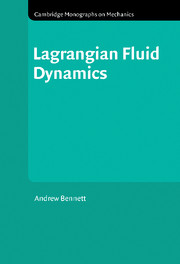Book contents
- Frontmatter
- Contents
- Preface
- Acknowledgments
- PART I THE LAGRANGIAN FORMULATION
- PART II LAGRANGIAN FLOWS
- PART III DIFFUSION
- Introduction
- 10 Absolute dispersion
- 11 Relative dispersion
- 12 Convective subranges of the scalar variance spectrum
- 13 Diffusion
- PART IV LAGRANGIAN DATA
- References
- Subject Index
- Author Index
Introduction
from PART III - DIFFUSION
Published online by Cambridge University Press: 06 July 2010
- Frontmatter
- Contents
- Preface
- Acknowledgments
- PART I THE LAGRANGIAN FORMULATION
- PART II LAGRANGIAN FLOWS
- PART III DIFFUSION
- Introduction
- 10 Absolute dispersion
- 11 Relative dispersion
- 12 Convective subranges of the scalar variance spectrum
- 13 Diffusion
- PART IV LAGRANGIAN DATA
- References
- Subject Index
- Author Index
Summary
A principal objective of any theory of fluid motion is the prediction of the spread of matter or “tracer” within the fluid. The problem is trivial for the fluid particles themselves in steady flow: they follow streamlines. It is nontrivial if the motion is time dependent, or if the tracer is dissolved in the fluid but diffusing through it. The time dependence of general interest is turbulence. The next four chapters develop a coherent framework for considering inhomogeneous and nonstationary turbulence, with elaboration in detail for the homogeneous, stationary and incompressible case, excluding and including tracer diffusion. Applications to the spread of phytoplankton are of special interest to oceanographers; these marine organisms are modeled as reacting tracers having nonlinear reaction rates. Absolute dispersion is considered first. This is the problem of predicting the path of a single fluid particle, or the path of the centroid of a cluster of particles, in turbulent flow. Turbulence being conceived as a random process, the problem is the prediction of the probability distribution function or pdf for the particle path. The mathematical difficulty is the closure of the infinite heirarchy of moments of the nonlinear kinematics, that is, the relating of certain high-order moments of particle displacement to low-order moments. There are any number of workings of this task in the literature, most of which close at second order, that is, second moments are related to first.
- Type
- Chapter
- Information
- Lagrangian Fluid Dynamics , pp. 119 - 122Publisher: Cambridge University PressPrint publication year: 2006



